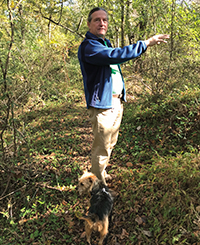A cold rain falls on Durham. Per the laws of physics, when the water hits the ground it runs downhill. It follows the path of least resistance, carrying with it the detritus of American consumer culture—Pepsi bottles, potato chip bags, six-pack rings, Miller Lite cans. It flows along roadsides and into storm drains. It emerges from culverts, where Lilliputian cascades feed ditches and gullies. It washes a cornucopia of garbage into Ellerbe Creek.
“We just keep feeding the beast,” says Ian Pond, observing the creek several days before the storm. That day, the water level was several feet lower, leaving bright strips of plastic visible on Ellerbe’s banks, in the underbrush, and tangled in low-hanging branches. Pond, board secretary of Ellerbe Creek Watershed Association (ECWA), knows that Ellerbe Creek feeds Falls Lake—Raleigh’s reservoir—where he’s seen trash islands a hundred feet wide, forty feet deep, and dense enough to stand on.
A few miles south, a small team of Duke freshmen is working to help starve the beast—that, or at least mitigate the amount of trash that makes it from street to stream. Mia Thompson, Danny Gonzalez, Davis Finfrock, Jihyeon “JJ” Je, and Shaan Gondalia are five of the 300-plus Pratt School of Engineering freshmen enrolled in the required First-Year Design (FYD) program, and designing an effective trash trap is this team’s semester-long project. Working out of the Design Pod or the Foundry, carved a few years ago into the basement of Gross Hall, other teams work to fit the needs of the Duke Lemur Center, Skanska (the construction company responsible for many of the campus’ recent buildings), the Museum of Life and Science in Durham, and a range of organizations and individuals. A few months ago, Thompson, Gonzalez, Finfrock, Je, Gondalia, and their classmates were high-school seniors. Now they’re facing engineering challenges with real-world ramifications—and potential for real-world innovation. In prior years, a book holder designed for David M. Rubenstein Rare Book and Manuscript Library and an adjustable painting hook developed for the Nasher Museum have both made their way to the patent process.
The design-driven curriculum “has thrown us head-first into doing hands-on engineering,” Finfrock says. “I really like that. It brings together all [types of ] engineers, and you can combine a lot of aspects of engineering into one single project.” FYD feels less like a class in the traditional sense, Thompson adds, but is more about providing Duke engineering students with the foundations and resources to find and maintain their footing.
For this team, that experience takes place in the Design Pod—the glass-walled ovoid that until 2017 housed the café Blue Express—but also in a wetlands preserve tucked behind a North Durham shopping center. The aptly named Beaver Marsh is one of ECWA’s five public preserves, and on its thirty-four acres Pond has seen bald eagles, snapping turtles, mink, otters, coyotes, and even one enormous wild turkey. The FYD students weren’t the first engineers here, Pond points out: The beavers who built a sizable lodge in the center of the marsh diligently maintain channels deep enough to kayak in and a tiered system of dams that Pond compares to the locks of the Suez Canal.
ECWA has worked with FYD students since the program’s pilot year in 2017, making this the third team to design a trash trap. Teams one and two used mesh in their designs, which captured too much natural debris and caused the traps to clog, sink, or break, or positioned their traps in the creek itself, which swells to a dynamic torrent after a hard rain. The 2019 team’s trap abandons mesh entirely and is designed to sit about fifteen feet downstream from a culvert; if this approach works, it’ll be replicated below other storm drains. If not?
“Personally, I think we all really, really want this to work better than the past few years,” says Thompson. “If we fail, another thing to rule out.”
This is by design, says FYD director Ann Saterbak, who instituted this program when she came to Duke from Rice University in 2017. Project-based design courses are typically reserved for upperclassmen, with the frosh learning principles first, application later. By the FYD approach, however, nascent engineers learn to swim by swimming—and they’re encouraged to learn from failure rather than view it as defeat.
“The idea of iteration is kind of baked into the course,” Saterbak says. “The grading system is not punitive toward mistakes, and the faculty, the TAs, we celebrate learning rather than perfection.”
Pond takes an engineer’s mindset, too. Since 2017, each trap has crept closer and closer to the source of the trash, moving upstream and out of the creek and into the ditches and gullies that feed it. And this year’s iteration could be the one that catches litter before it can wash into Falls Lake—that, or it could be one more step toward the final design.
“We’ll see,” says Pond.


Share your comments
Have an account?
Sign in to commentNo Account?
Email the editor